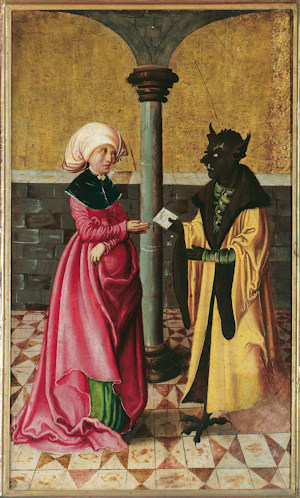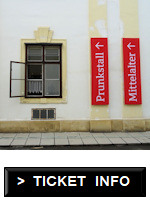Prunk means pageantry or splendour, and stall means stable. So the Prunkstall is where Belvedere’s horses probably enjoyed better housing than many people of the time. Today, it’s home to the gallery’s medieval collection.
- Part of the Lower Belvedere complex
- Altar panels, paintings, and statues
- Just three rooms, so quick to get around
- The Belvedere is a dynamic museum, so the actual works on display may vary
- All info available in English and German
- Book Lower Belvedere tickets* online
- See also:
The stables

(Interior of the Prunkstall: the Belvedere Medieval collection; press photo © Lukas Schaller / Belvedere, Wien)
You get a feel for the original purpose of this building from the horse-faced reliefs on the decorated ceiling and the stone water basins along the walls of the largest gallery.
However, the only horses inside the Prunkstall today are those pictured in the religious art on display: the three main rooms host Belvedere’s medieval collection, though many of the true masterpieces have moved to the upper palace.
The medieval highlights
In the first gallery, walls that once held hay now bear altar panels and paintings from the 15th and 16th centuries, as well as the giant Rogendorf fir altarpiece from around 1495.
The second gallery has more of the same, while the third features sombre-looking statues made of sandstone, pottery and various types of timber that include limewood, Swiss stone pine, walnut and willow.
The art appears in themed groups, such as depictions of saints or Mary, and the condition of the works is often extraordinary when you remember they can date back over 500 years.
Though these are not the crème de la crème of the Belvedere medieval collection, you still have much to enjoy.
For example, eight impressively huge panels from the Salzburg Altarpiece, made in around 1490/1491 by Rueland Frueauf the Elder, greet you immediately on your left as you enter the collection.

(This messenger seems a little suspicious. Photo courtesy of and © Belvedere, Wien. Reproduced with permission under the terms of Creative Commons License CC BY-SA 4.0.)
As a non-expert, here are my highlights along with their location number, as given in the free guide booklet available at the stables entrance…
- I enjoyed the rather unpleasant devil character in the early 16th century painting of a scene from the legend of St. Cosmas and St. Damian (see photo above – number 15 in Room 1 in the guide booklet)
- Not sure if it was deliberate, but the painting of the Adoration of the Magi from around 1500 (number 29 in Room 1) has Joseph (or perhaps the innkeeper?) at the back looking slightly miffed at the lack of attention
- The painting of the martyrdom of St. Erasmus from around 1500 (number 6 in Room 2) doesn’t hold back in its depiction of how that martyrdom came to be (grotesque torture instrument included). No spoilers, but Erasmus is kind of the patron saint of abdominal pain
- My wife says it’s not an anachronism, but the painting of St.Ambrose from 1498 (number 4 in Room 2) shows him wearing a pair of glasses
Tickets & visitor tips
Any ticket from or for Lower Belvedere includes entry to the stables and medieval collection.
(Booking service provided by Tiqets.com*, who I am an affiliate of)
Vienna has other medieval gems outside of Belvedere’s collections, of course. Consider, for example:
- A visit to the Schottenstift museum, home to the Schottenaltar panel paintings
- The Wien Museum on Karlsplatz has a section in its permanent exhibition dedicated to that era
- Two abbeys close to Vienna have their own medieval exhibits: Melk and Klosterneuburg
- Several of today’s central Viennese churches once attended to the spiritual needs of medieval folk:
- The Gothic Stephansdom cathedral, of course
- Ruprechtskirche, Maria am Gestade, Kirche am Hof, Michaelerkirche and Augustinerkirche churches
- The Hofburgkapelle chapel in the Hofburg palace complex
Getting to the Prunkstall
See the directions for Belvedere article. You access the Prunkstall from the end of the west wing of Lower Belvedere. Just follow the signs once inside the palace.
Address: Rennweg 6, 1030 Vienna
N.B. Don’t forget the r: a Punkstall would be something completely different.
